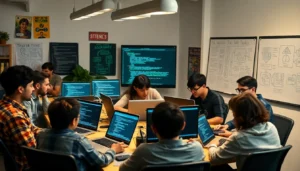Table of Contents
ToggleIn a world where swiping right has become the new way to say hello, technology’s grip on social skills is tighter than ever. As screens replace face-to-face conversations, one has to wonder: are we becoming social butterflies or digital hermits? The truth is, while technology offers convenience, it also poses a unique challenge to our ability to connect with others in meaningful ways.
Imagine trying to make small talk with a toaster—awkward, right? Yet, that’s the reality for many who rely on devices for interaction. As we dive into the impact technology has on social skills, it’s time to explore whether our thumbs are becoming more agile than our tongues. Buckle up; this journey through the digital landscape might just reveal a few surprises about how we communicate in the modern age.
Overview of Technology and Social Skills
Technology significantly influences social skills, shaping how individuals interact in the digital landscape. Digital communication presents both opportunities and challenges for social engagement.
Definition of Social Skills
Social skills encompass the ability to communicate effectively, build relationships, and engage in social situations. These skills include verbal and non-verbal communication, active listening, empathy, and conflict resolution. They allow individuals to navigate different social contexts. Mastering these skills leads to deeper connections and enhances personal and professional relationships. As society evolves, understanding the components of social skills becomes essential for meaningful interactions.
The Role of Technology in Modern Communication
Modern communication relies heavily on technology, transforming how people connect with one another. Individuals use smartphones, social media platforms, and instant messaging to interact. While these tools offer convenience, they may also hinder face-to-face interactions. Many rely on emojis and gifs to convey emotions, which can lead to misunderstandings. Technology enables instant communication, yet it may promote superficial relationships over deeper connections. The balance between digital and in-person communication is crucial for maintaining and developing social skills.
Positive Impacts of Technology on Social Skills

Technology enhances social skills in various ways by improving communication and creating new opportunities for interaction.
Enhancements in Connectivity
Technology strengthens connectivity among individuals, allowing conversations across distances in real time. Virtual platforms like Zoom and social media enable users to maintain relationships without geographical barriers. Increased contact with friends and family fosters a sense of belonging, even during separation. Text messaging and instant messaging applications promote quick exchanges, helping users stay engaged. This constant interaction can build confidence in expressing thoughts and feelings. Ensuring accessibility to people worldwide encourages more extensive social networks, thus facilitating collaboration and support.
Access to Diverse Perspectives
Technology opens doors to diverse perspectives, enriching conversations and broadening understanding. Online forums and social media expose users to various cultural viewpoints. Engaging in discussions with individuals from different backgrounds enhances empathy and tolerance. Exposure to multiple ideas encourages critical thinking, helping individuals navigate complex social environments. Access to educational resources, including webinars and podcasts, allows users to learn from experts across fields. Utilizing these platforms fosters collaboration, enabling groups to tackle challenges collectively. Connectedness through technology nurtures open-mindedness and adaptability in social skills development.
Negative Impacts of Technology on Social Skills
Technology significantly reduces face-to-face interactions, which are crucial for developing social skills. Individuals often prefer texting or messaging over engaging in person. This shift leads to a decline in meaningful conversations. Essentially, it fosters an environment where quick exchanges replace in-depth discussions. Children particularly miss opportunities to learn social cues, body language, and conversational rhythm, all vital components of effective communication.
Empathy and emotional intelligence suffer due to technology’s prevalence. Many people find it easier to communicate through screens, which diminishes personal connections. Instant messaging lacks the nuance of voice tone and facial expressions, making it harder to gauge feelings. Furthermore, individuals develop a reliance on digital interactions, often resulting in superficial relationships. Studies suggest that these changes impact the ability to understand others’ emotions, leading to a less empathetic society.
Case Studies
Research showcases the varied effects of technology on social skills. Several specific examples illustrate how different demographics experience these changes.
Technology Use Among Adolescents
Adolescents increasingly rely on technology for communication. Data indicates that 92% of teens use social media daily. Many prefer texting, which limits opportunities for face-to-face conversations. This shift reduces their ability to read non-verbal cues and develop essential interpersonal skills. Furthermore, studies reveal that teens miss the nuances of in-person interactions, such as body language and tone, affecting their social competence. Participating in online communities can help develop connections, yet the lack of direct communication often leads to misunderstandings and shallow relationships.
Professional Environments and Remote Work
In professional settings, technology reshapes communication dynamics. A recent survey found that 48% of remote workers engage primarily through digital platforms. These platforms streamline collaboration but alter relationship-building processes. Face-to-face interaction fosters deeper connections; its absence can result in weaker team cohesion. Employees often struggle to convey emotions or nuances through emails or video calls. Acknowledging these challenges allows organizations to implement strategies focused on enhancing interpersonal skills among remote teams. Building virtual social events and encouraging regular check-ins can help strengthen relationships despite technological barriers.
Technology’s influence on social skills is undeniable and multifaceted. While it offers convenience and connectivity, it also poses challenges that can hinder genuine interactions. Striking a balance between digital communication and face-to-face engagement remains essential for nurturing meaningful relationships.
As society continues to navigate this digital landscape, understanding the impact of technology on social skills is crucial. Individuals must be mindful of their communication habits and actively seek opportunities to engage in person. By doing so, they can foster deeper connections and enhance their ability to empathize with others. Embracing both the advantages and limitations of technology will ultimately lead to a more socially adept society.







